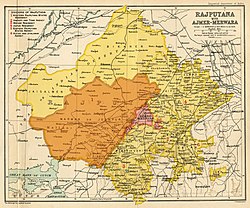
Back مملكة ماروار Arabic Jodhpur Catalan État de Jodhpur French जोधपुर रियासत Hindi Jodhpur (stato) Italian マールワール王国 Japanese 마르와르 왕국 Korean ریاست جودھ پور PNB Джодхпур (княжество) Russian جودھ پور ریاست SKR
Kingdom of Marwar Jodhpur State | |
|---|---|
| |
 The Kingdom of Marwar at its greatest extent c.. 1539, under Maldeo Rathore | |
Marwar or Jodhpur State in 1909 | |
| Status |
|
| Capital | |
| Common languages | Marwari |
| Religion | Hinduism |
| Government | Monarchy |
| Maharaja | |
• 1226–1273 | Rao Siha (first) |
• 1947–1949 | Hanwant Singh (last) |
| History | |
• Establishment | 1226 |
• Annexed by the Mughal Empire | 1581 |
• Restored as a vassal state | 1583 |
• Acceded to the Indian Union | 1818 |
| Area | |
| 1947 | 93,424 km2 (36,071 sq mi) |
| Today part of | Rajasthan, Republic of India |
Kingdom of Marwar, also known as Jodhpur State during the modern era, was a kingdom in the Marwar region from 1243 to 1818 and a princely state under British rule from 1818 to 1947. It was established in Pali by Rao Siha, possibly a migrant Gahadavala noble, in 1243. His successors continued to struggle against regional powers for domination and 9 out of 15 rulers till 1438 died in combat. In 1395, its capital was changed to Mandore by Rao Chunda of Mandore and to Jodhpur in 1459 by Rao Jodha.
Marwar struggled and resisted against the Mughals under the rule of Rao Ganga and Maldeo Rathore who is known to be one of the greatest warriors of the time. The kingdom remained independent until it was annexed by the Mughal Empire in 1581 after the death of Chandrasen Rathore. It remained under direct Mughal control until Udai Singh was restored to the throne as a vassal and given the title of Raja in 1583. During the late 17th century it was under the strict control of the Mughal Emperor Aurangzeb, but the ruling house of Rathore was allowed to remain semi-autonomous in their territory.
Marwar came into a long period of dispute and war with the Mughals when Raja Jaswant Singh died in 1678 and was supposed to be succeeded by his posthumous-born son Ajit Singh but Ajit was not appointed the ruler by Aurangzeb. During this time Durgadas Rathore struggled to preserve the Rathore dynasty and freed Marwar from the Mughal Empire after 31 years of war. In the late 18th and early 19th centuries the kingdom was overrun by the Maratha hordes of Scindia and Holkar. Marwar was financially bankrupt due to heavy tributes exacted by the Marathas and its once renowned army had now thinned down because of internal wars and rebellions by its nobles, forcing its rulers to ask the British for aid.
The British had no role in the state's affairs until 6 January 1818, when the Raja at that time, Man Singh, entered into a subsidiary alliance, after which the Rajas of Marwar (or Jodhpur) continued as rulers of a princely state. During the Indian Rebellion of 1857, the Rajput Nobles under Thakur Kushal Singh of Auwa led a rebellion against Maharaja Takht Singh and the British, however the rebellion was put to an end by the British armies under Colonel Holmes after a siege of the Thakur's fort in Auwa.[5] The armies of Jodhpur State fought in World War I for the British. They actively fought in Afghanistan and the Middle-east and scored a series of victories for the British empire. The Jodhpur lancers with the support of the Mysore lancers defeated a large host of Turks and Germans in the Battle of Haifa (1918). Some of the other battles they participated in were the battles of Suez, Gaza, Jordan Valley, Abu Tellul and Megiddo.
Following Indian independence in 1947 Maharaja Hanwant Singh, the last ruler of Jodhpur state signed the Instrument of Accession on 11 August 1947 and merged his state in Union of India.
- ^ U.N Day (1978). Mewar Under Maharana Kumbha, 1433 A.D.-1468 A.D. Rajesh Publications. p. 30.
Kumbha has been deliberately assigned a young age to glorify Ranmal Rathor and to give him all the earlier achievement of Maharana Kumbha. In reality Ranmal served Maharana Kumbha as one his samants and during his tenure worked hard to augment his own position and power.
- ^ Somani, R.V (1995). Maharana Kumbha and his times. pp. 72–76.
- ^ Majumdar, R.C (1960). History and Culture of Indian people volume 6. BHARATIYA VIDYA BHAVAN. p. 344.
Sahga's success against Ibrahim Lodi was the crowning achieve¬ ment of his career. It was the culmination of a series of successes against his neighbours, as a consequence of which the boundaries of Mewar were considerably extended. On the north they were pushed up as far as the Bayana river. In the east, Raisen, Kalpi and Chanderl were included within her territories. In the south, Dungarpur and Banswara were held by a vassal, and her frontiers ran far into the heart of Malwa. To the south-west, Sirohi was ruled by the Rana's son-in-law. Even the chiefs of Mar war and Ambar, according to Tod, acknowledged his allegianc.
- ^ Rima Hooja 2006.
- ^ Political Awakening and Indian Freedom Movement with Special Reference to Rajasthan pg 28–35
Cite error: There are <ref group=lower-alpha> tags or {{efn}} templates on this page, but the references will not show without a {{reflist|group=lower-alpha}} template or {{notelist}} template (see the help page).



